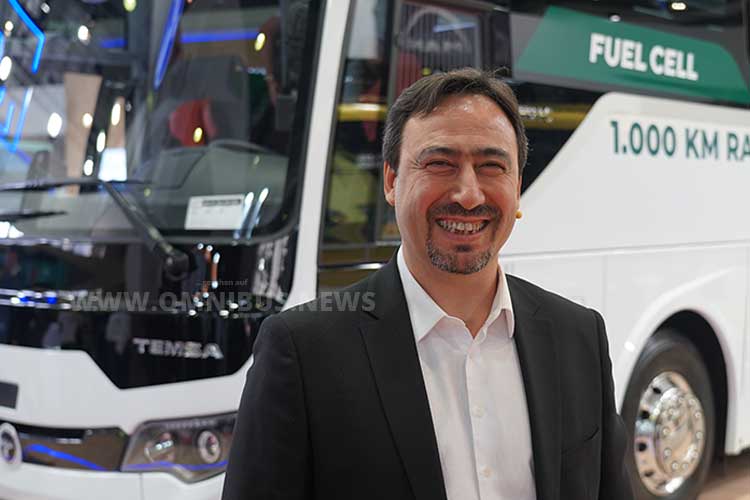
Tolga Kaan Doğancıoğlu, CEO von Temsa, hat auf der Busworld einen FCEV-Reisebus präsentiert. Foto: Schreiber
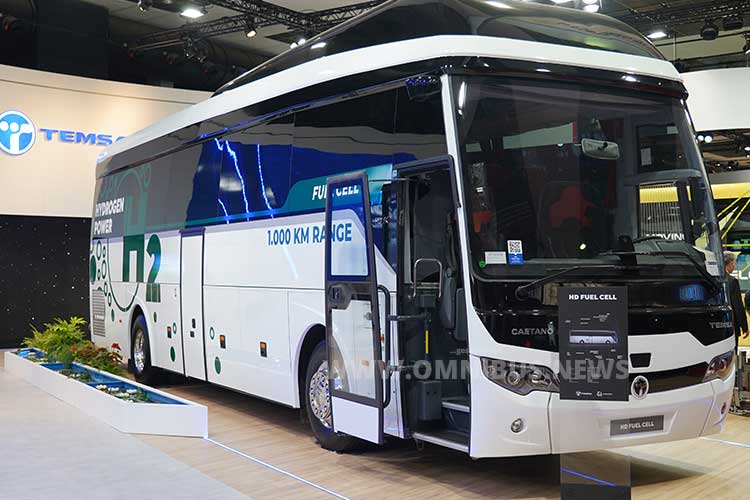
Temsa hat auf der Busworld einen FCEV-Reisebus auf Basis der HD-Baureihe vorgestellt. Foto: Schreiber
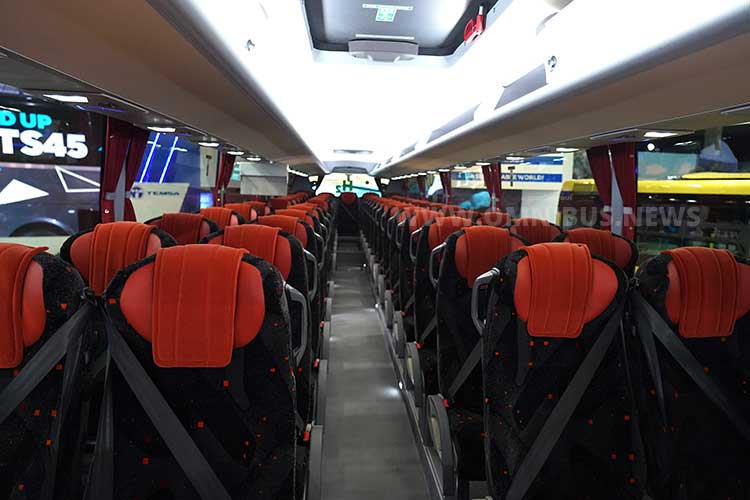
Bis zu 53 Fahrgäste können im FCEV-Reisebus von Temsa mitfahren. Foto: Schreiber
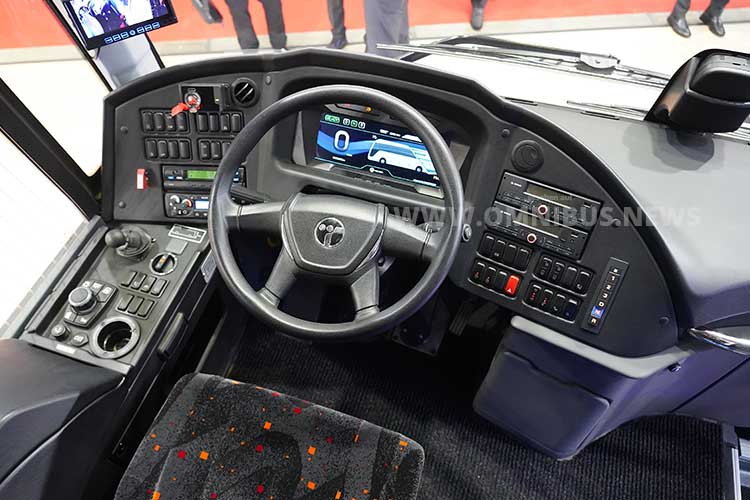
Der Fahrerarbeitsplatz entspricht fast dem der HD-Baureihe – bis auf die Komponenten für den FCEV-Anzeige im neuen digitalen Cockpit. Foto: Schreiber
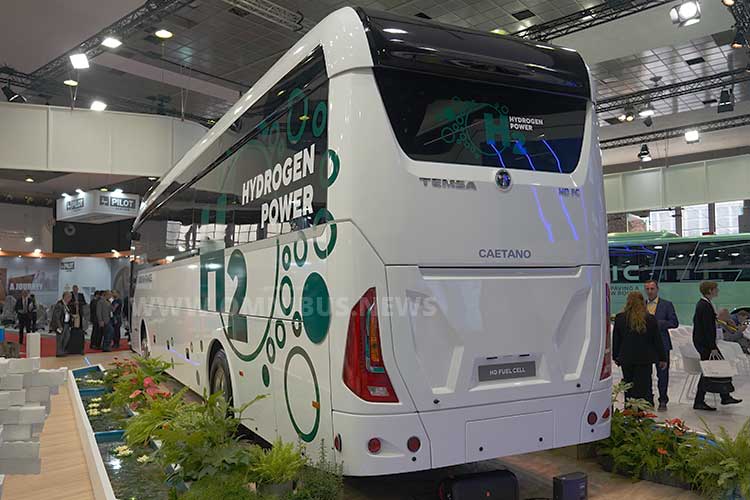
Ab 2025 lieferbar: Der Temsa FCEV-Reisebus. Foto: Schreiber
2025 will Temsa einen FCEV-Reisebus an Kunden ausliefern. 1.000 km Reichweite und auf Basis der HD-Baureihe sowie mit Unterstützung von Caetano Bus ist das ein echter Knaller – wenn man den Antrieb sieht – im Portfolio von Temsa. Damit aber nicht genug, wie Tolga Kaan Doğancıoğlu, CEO von Temsa, ankündigte.
Während seines Vortrags auf der Busworld über die Produkte aus dem Hause Temsa waren auf einer der den Vortrag unterstützenden Folien für das Portfolio im Bereich der BEV- und FCEV-Busse je zwei neue Omnibusse zu sehen – geschwärzt, um nicht zu viel über Baureihe und Baumuster zu verraten.
Man sei auf einem guten Kurs, so Doğancıoğlu. In der Region EMEA (Europa, Naher Osten und Afrika) habe man ein Wachstum von 171 Prozent, in Westeuropa von 77 Prozent erreicht. „Weltweit haben wir eine Wachstumsleistung von 61 Prozent auf Euro-Basis,“ so Doğancıoğlu.
Eines der vier neuen Fahrzeuge ist der auf der Busworld ausgestellte Prototyp, der bis Ende nächsten Jahres am Temsa Standort in Adana getestet und finalisiert werde, damit dann ab 2025 die Serienfertigung starten könne, wie der CEO von Temsa erklärte. Zum Preis machte er auf der Busworld aber keine Angaben, interessierte Kunden könnten aber schon eine Absichtserklärung unterschreiben.
Offen und ehrlich gab Tolga Kaan Doğancıoğlu zu, dass die Reichweite unter Berücksichtigung des Einsatzortes und der klimatischen Verhältnisse variieren werde, die 1.000 km seien aber darstellbar. „Eine der Herausforderungen ist die Reichweite. Wenn wir also von einer Revolution der lokal emissionsfreien Omnibusse sprechen wollen, müssen wir technologieoffen sein und über batterieelektrische wie wasserstoffbetriebene Fahrzeuge sprechen.“
Technische Details und Ausstattungsmerkmale des FCEV-Reisebusses seien noch nicht in Stein gemeißelt, hier würde die Zeit der Fahrerprobung im nächsten Jahr sicherlich noch die eine oder andere technische Veränderung mit sich bringen. Aktueller Stand der Dinge: Der FCEV-Reisebus sei für bis zu 53 Fahrgäste gedacht, wahlweise mit 350/700bar verfügbar und mit 72,8 kg Wasserstoff an Bord unterwegs. Zusätzlich gibt es noch Batterien mit 160 kWh, diese können bei hohem Leistungsbedarf einen Boost liefern (geladen werden sie durch regeneratives Bremsen oder von der Brennstoffzelle).
Die Brennstoffzelle hat eine voraussichtliche Lebensdauer von 35.000 Stunden. Angetrieben wird der FCEV-Reisebus-Prototyp von einem TM Sumo HD4-Motor mit einer Leistung von 350 kW. Die Wasserstofftanks befinden sich an der Vorderseite des Omnibusses, die Brennstoffzelle von Toyota befindet sich am Heck, wo sonst ein Motor wäre. Der Fahrgastraum ist, wie auch der Fahrerarbeitspltz, weitgehend mit dem des HD12 identisch ist – lediglich ein digitales Armaturenbrett, das auch spezifische Informationen für den Wasserstoffantrieb anzeigt, hat als neuheit Einzug gehalten.
Neben unseren Wasserstofffahrzeugen für den Stadtverkehr, die wir gemeinsam mit unserer Schwestergesellschaft Skoda Transportation entwickelt und in der vergangenen Zeit in Prag auf die Straße gebracht haben, integrieren wir diese Technologie nun auch in den anderen Segmenten.“
Im Gespräch mit omnibus.news auf der Busworld äußerte sich Tolga Kaan Doğancıoğlu zum Wandel in der Busbranche und dem Portfolio von Temsa: „Heute demonstrieren wir unser Engagement für Nachhaltigkeit mit einer Produktpalette, die zehn verschiedene Fahrzeuge umfasst, darunter acht Elektro- und zwei wasserstoffbetriebene Fahrzeuge.“
Doğancıoğlu sieht sich durch Auszeichnungen auf dem Weg bestätigt: „Wir freuen uns, bekannt geben zu können, dass wir ein EPD-Zertifikat (Environmental Product Declaration) für unseren Avenue Electron-Bus erhalten haben, Wir sind der sechste Hersteller weltweit, der ein solches Zertifikat für einen Bus erhalten hat.“
Man lebe Nachhaltigkeit auch im Unternehmen, so Doğancıoğlu: „Wenn wir das Jahr 2021 als Ausgangspunkt nehmen, haben wir bis Ende 2022 in der Produktion eine signifikante Reduzierung des Wasserverbrauchs pro Fahrzeug um 19 Prozent und eine bemerkenswerte Reduzierung der Scope-1- und Scope-2-Emissionen um 29 Prozent erreicht. Derzeit beziehen wir in unseren Produktionsstätten den dort verbrauchten Strom aus erneuerbaren Energiequellen.“
Bei allem Positivem müsse man aber nach Aussagen von Tolga Kaan Doğancıoğlu sich immer wieder die aktuelle Situation der Busbranche vor Augen führen: Ob Probleme mit Lieferanten bzw. globalen Lieferketten, der drohende Fahrermangel in Europa oder steigende kosten, es sei nicht einfach. Und das Erdbeben, das die Türkei im Februar 2023 erschütterte, sei für Temsa noch einmal eine Herausforderung gewesen. (Temsa/omnibus.news/PM/Sr)
In 2025, Temsa wants to deliver an FCEV coach to customers. 1,000 km range and based on the HD series as well as with support from Caetano Bus will then be a real banger – if you look at the drive – in Temsa’s portfolio. But that’s not all, as Tolga Kaan Doğancıoğlu, CEO of Temsa, announced.
During his presentation at Busworld on Temsa’s products, two new buses were shown on one of the slides supporting the presentation for the BEV and FCEV bus portfolio – blacked out so as not to reveal too much about the series and model.
According to Doğancıoğlu, the company is on a good course. In the EMEA region (Europe, Middle East and Africa), they achieved growth of 171 per cent, and in Western Europe of 77 per cent, he said. „Globally, we have a growth performance of 61 per cent on a euro basis,“ Doğancıoğlu said.
One of the four new vehicles is the prototype exhibited at Busworld, which will be tested and finalised at the Temsa site in Adana by the end of next year so that series production can then start from 2025, the Temsa CEO explained. However, he did not give any details on the price at Busworld, but interested customers could already sign a letter of intent.
Tolga Kaan Doğancıoğlu openly and honestly admitted that the range would vary, taking into account the place of use and the climatic conditions, but that the 1,000 km was feasible. „One of the challenges is the range. So if we want to talk about a revolution in locally emission-free buses, we have to be open to technology and talk about battery-electric as well as hydrogen-powered vehicles.“
Technical details and equipment features of the FCEV coach are not yet set in stone, he said, adding that the period of driver testing next year would certainly bring one or two technical changes. The current state of affairs is that the FCEV coach is intended for up to 53 passengers, is available with a choice of 350/700 bar and travels with 72.8 kg of hydrogen on board. In addition, there are batteries with 160 kWh, these can provide a boost when power demand is high (they are charged by regenerative braking or by the fuel cell).
The fuel cell has an expected lifetime of 35,000 hours. The prototype FCEV coach is powered by a TM Sumo HD4 engine with an output of 350 kW. The hydrogen tanks are located at the front of the bus, the Toyota fuel cell is located at the rear where an engine would otherwise be. The passenger compartment, like the driver’s workplace, is largely identical to that of the HD12 – only a digital dashboard, which also displays specific information for the hydrogen drive, has been introduced as a novelty.
In addition to our hydrogen vehicles for urban transport, which we developed together with our sister company Skoda Transportation and launched on the road in Prague last time, we are now integrating this technology in the other segments as well.“
Speaking to omnibus.news at Busworld, Tolga Kaan Doğancıoğlu commented on the change in the bus industry and Temsa’s portfolio: „Today we are demonstrating our commitment to sustainability with a product range that includes ten different vehicles, including eight electric and two hydrogen-powered vehicles.“
Doğancıoğlu sees awards confirming his path: „We are pleased to announce that we have received an EPD (Environmental Product Declaration) certificate for our Avenue Electron bus, We are the sixth manufacturer worldwide to receive such a certificate for a bus.“
They also live sustainability in the company, Doğancıoğlu said, „If we take 2021 as a starting point, by the end of 2022 we will have achieved a significant reduction of 19 per cent in water consumption per vehicle in production and a remarkable 29 per cent reduction in Scope 1 and Scope 2 emissions. We currently source the electricity used at our production facilities from renewable energy sources.“
Despite all the positive things, Tolga Kaan Doğancıoğlu said that the current situation in the bus industry must always be kept in mind: Whether it’s problems with suppliers or global supply chains, the looming driver shortage in Europe or rising costs, it’s not easy. And the earthquake that shook Turkey in February 2023 was yet another challenge for Temsa. (Temsa/omnibus.news/PM/Sr)
